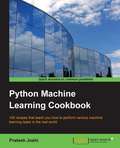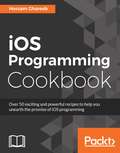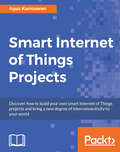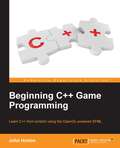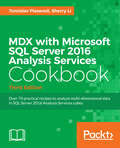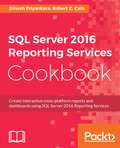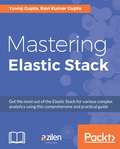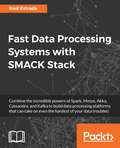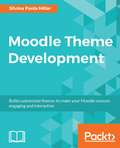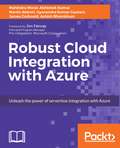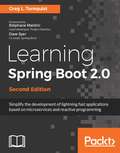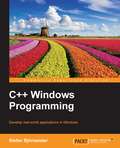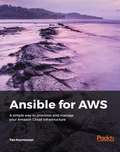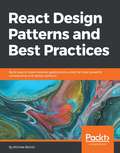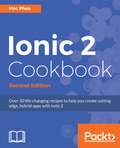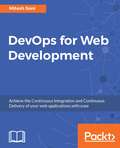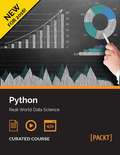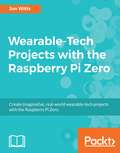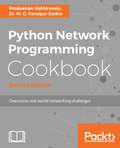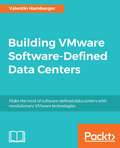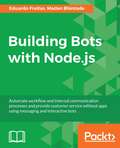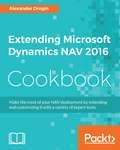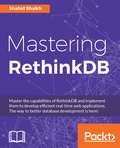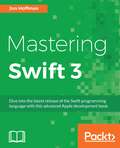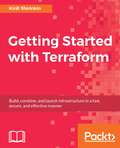- Table View
- List View
Python Machine Learning Cookbook
by Prateek JoshiThis book is for Python programmers who are looking to use machine-learning algorithms to create real-world applications. This book is friendly to Python beginners, but familiarity with Python programming would certainly be useful to play around with the code.
iOS 10 Programming Cookbook
by Hossam GhareebIf you are an iOS developer on a quest to develop your perfect iOS app, then this book is for you. It would also prove to be a valuable resource for those who want to get up and running with iOS development through a clear, practical approach. In order to unleash the full potential of this book, basic Swift programming knowledge is necessary.
Smart Internet of Things Projects
by Agus KurniawanDiscover how to build your own smart Internet of Things projects and bring a new degree of interconnectivity to your world About This Book • Learn how to extract and analyse data from physical devices and build smart IoT projects • Master the skills of building enticing projects such as a neural network autonomous car, computer vision through a camera, and cloud-based IoT applications • This project-based guide leverages revolutionary computing chips such as Raspberry Pi, Arduino, and so on Who This Book Is For If you are hobbyist who is keen on making smart IoT projects, then this book is for you. You should have a basic knowledge of Python. What You Will Learn • Implement data science in your IoT projects and build a smart temperature controller • Create a simple machine learning application and implement decision system concepts • Develop a vision machine using OpenCV • Build a robot car with manual and automatic control • Implement speech modules with your own voice commands for IoT projects • Connect IoT to a cloud-based server In Detail Internet of Things (IoT) is a groundbreaking technology that involves connecting numerous physical devices to the Internet and controlling them. Creating basic IoT projects is common, but imagine building smart IoT projects that can extract data from physical devices, thereby making decisions by themselves. Our book overcomes the challenge of analyzing data from physical devices and accomplishes all that your imagination can dream up by teaching you how to build smart IoT projects. Basic statistics and various applied algorithms in data science and machine learning are introduced to accelerate your knowledge of how to integrate a decision system into a physical device. This book contains IoT projects such as building a smart temperature controller, creating your own vision machine project, building an autonomous mobile robot car, controlling IoT projects through voice commands, building IoT applications utilizing cloud technology and data science, and many more. We will also leverage a small yet powerful IoT chip, Raspberry Pi with Arduino, in order to integrate a smart decision-making system in the IoT projects. Style and approach The book follows a project-based approach to building smart IoT projects using powerful boards such as the Raspberry Pi, Arduino, and the IoT chip.
Beginning C++ Game Programming
by John HortonLearn C++ from scratch using the OpenGL-powered SFMLAbout This BookThis book offers a fun way to learn modern C++ programming while building exciting 2D gamesThis beginner-friendly guide offers a fast-paced but engaging approach to game developmentDive headfirst into building a wide variety of desktop games that gradually increase in complexityIt is packed with many suggestions to expand your finished games that will make you think critically, technically, and creativelyWho This Book Is ForThis book is for those who have no C++ programming knowledge whatsoever and want to learn to build games or just use games as a more engaging way to learn C++. If you have aspirations of one day publishing a game on Steam or just want to have a load of fun while learning C++, then this book was written for you.What You Will LearnGet to know C++ from scratch while simultaneously learning about building gamesMake C++ game coding appear like it is something that any determined person can doGet a competent level knowledge of C++ programming.Build exciting games with a wide range of featuresGet ready to go and build your own unique gamesIn DetailThis book is all about offering you a fun introduction to the world of game programming and C++. It will begin by teaching you the programming basics such as variables, loops, and conditions using game-like mini apps.We then move on to build actual working games. Throughout the course of the book, you will learn to build three different styles of games comprising a frantic two-button-tapper, a zombie survival/shooter, and a multiplayer platformer. While building these games, you will learn some more C++ programming concepts such as OOP and data storage/complexity. We'll end by creating a multiplayer shooter game and will also introduce you to some of the advanced capabilities of C++ such as networking and advanced OOP.As the games gradually increase in complexity, you will explore some of the advanced capabilities of C++ as well as some exciting new game programming techniques.
MDX with Microsoft SQL Server 2016 Analysis Services Cookbook - Third Edition
by Tomislav Piasevoli Sherry LiOver 70 practical recipes to analyze multi-dimensional data in SQL Server 2016 Analysis Services cubes About This Book * Updated for SQL Server 2016, this book helps you take advantage of the new MDX commands and the new features introduced in SSAS * Perform time-related, context-aware, and business related-calculations with ease to enrich your Business Intelligence solutions * Collection of techniques to write flexible and high performing MDX queries in SSAS with carefully structured examples Who This Book Is For This book is for anyone who has been involved in working with multidimensional data. If you are a multidimensional cube developer, a multidimensional database administrator, or a report developer who writes MDX queries to access multidimensional cube, this book will help you. If you are a power cube user or an experienced business analyst, you will also find this book invaluable in your data analysis. This book is for you are interested in doing more data analysis so that the management can make timely and accurate business decisions. What You Will Learn * Grasp the fundamental MDX concepts, features, and techniques * Work with sets * Work with Time dimension and create time-aware calculations * Make analytical reports compact, concise, and efficient * Navigate cubes * Master MDX for reporting with Reporting Services (new) * Perform business analytics * Design efficient cubes and efficient MDX queries * Create metadata-driven calculations (new) * Capture MDX queries and many other techniques In Detail If you're often faced with MDX challenges, this is a book for you. It will teach you how to solve various real-world business requirements using MDX queries and calculations. Examples in the book introduce an idea or a problem and then guide you through the process of implementing the solution in a step-by-step manner, inform you about the best practices and offer a deep knowledge in terms of how the solution works. Recipes are organized by chapters, each covering a single topic. They start slowly and logically progress to more advanced techniques. In case of complexity, things are broken down. Instead of one, there are series of recipes built one on top of another. This way you are able to see intermediate results and debug potential errors faster. Finally, the cookbook format is here to help you quickly identify the topic of interest and in it a wide range of practical solutions, that is - MDX recipes for your success. Style and approach This book is written in a cookbook format, where you can browse through and look for solutions to a particular problem in one place. Each recipe is short, to the point and grouped by relevancy. All the recipes are sequenced in a logical progression; you will be able to build up your understanding of the topic incrementally.
SQL Server 2016 Reporting Services Cookbook
by Dinesh Priyankara Robert C. CainCreate interactive cross-platform reports and dashboards using SQL Server 2016 Reporting Services About This Book * Get up to speed with the newly-introduced enhancements and the more advanced query and reporting features * Easily access your important data by creating visually appealing dashboards in the Power BI practical recipe * Create cross-browser and cross-platform reports using SQL Server 2016 Reporting Services Who This Book Is For This book is for software professionals who develop and implement reporting solutions using Microsoft SQL Server. It is especially relevant for professionals who are software engineers, software architects, DW/BI engineers, and DW/BI architects who perform simple to complex report authoring implementations. This book is also suitable for those who develop software solutions that integrate reporting solutions and are keen to learn about Microsoft SQL Server 2016's features and capabilities. What You Will Learn * Key capabilities, architecture, and components of Reporting Services * New features that have been added to Reporting Services * Design the architecture for reporting solutions * Design the architecture for BI solutions * Implement reporting solutions using Reporting Services * Improve the performance, availability, and scalability of the reporting solution * Enhance reporting solutions with custom programming and improved security In Detail Microsoft SQL Server 2016 Reporting Services comes with many new features. It offers different types of reporting such as Production, Ad-hoc, Dashboard, Mash-up, and Analytical. SQL Server 2016 also has a surfeit of new features including Mobile Reporting, and Power BI integration. This book contains recipes that explore the new and advanced features added to SQL Server 2016. The first few chapters cover recipes on configuring components and how to explore these new features. You'll learn to build your own reporting solution with data tools and report builder, along with learning techniques to create visually appealing reports. This book also has recipes for enhanced mobile reporting solutions, accessing these solutions effectively, and delivering interactive business intelligence solutions. Towards the end of the book, you'll get to grips with running reporting services in SharePoint integrated mode and be able to administer, monitor, and secure your reporting solution. This book covers about the new offerings of Microsoft SQL Server 2016 Reporting Services in comprehensive detail and uses examples of real-world problem-solving business scenarios. Style and approach This comprehensive cookbook follows a problem-solution approach to help you overcome any obstacle when creating interactive, visually-appealing reports using SQL Server 2016 Reporting Services. Each recipe focuses on a specific task and is written in a clear, solution-focused style.
Mastering ELK Stack
by Yuvraj Gupta Ravi Kumar GuptaThis book cater to developers using the ELK stack in their day-to-day work who are familiar with the basics of Elasticsearch, Logstash, and Kibana, and now want to become an expert at using the ELK stack for data analytics.
Fast Data Processing Systems with SMACK Stack
by Raul EstradaCombine the incredible powers of Spark, Mesos, Akka, Cassandra, and Kafka to build data processing platforms that can take on even the hardest of your data troubles! About This Book • This highly practical guide shows you how to use the best of the big data technologies to solve your response-critical problems • Learn the art of making cheap-yet-effective big data architecture without using complex Greek-letter architectures • Use this easy-to-follow guide to build fast data processing systems for your organization Who This Book Is For If you are a developer, data architect, or a data scientist looking for information on how to integrate the Big Data stack architecture and how to choose the correct technology in every layer, this book is what you are looking for. What You Will Learn • Design and implement a fast data Pipeline architecture • Think and solve programming challenges in a functional way with Scala • Learn to use Akka, the actors model implementation for the JVM • Make on memory processing and data analysis with Spark to solve modern business demands • Build a powerful and effective cluster infrastructure with Mesos and Docker • Manage and consume unstructured and No-SQL data sources with Cassandra • Consume and produce messages in a massive way with Kafka In Detail SMACK is an open source full stack for big data architecture. It is a combination of Spark, Mesos, Akka, Cassandra, and Kafka. This stack is the newest technique developers have begun to use to tackle critical real-time analytics for big data. This highly practical guide will teach you how to integrate these technologies to create a highly efficient data analysis system for fast data processing. We'll start off with an introduction to SMACK and show you when to use it. First you'll get to grips with functional thinking and problem solving using Scala. Next you'll come to understand the Akka architecture. Then you'll get to know how to improve the data structure architecture and optimize resources using Apache Spark. Moving forward, you'll learn how to perform linear scalability in databases with Apache Cassandra. You'll grasp the high throughput distributed messaging systems using Apache Kafka. We'll show you how to build a cheap but effective cluster infrastructure with Apache Mesos. Finally, you will deep dive into the different aspect of SMACK using a few case studies. By the end of the book, you will be able to integrate all the components of the SMACK stack and use them together to achieve highly effective and fast data processing. Style and approach With the help of various industry examples, you will learn about the full stack of big data architecture, taking the important aspects in every technology. You will learn how to integrate the technologies to build effective systems rather than getting incomplete information on single technologies. You will learn how various open source technologies can be used to build cheap and fast data processing systems with the help of various industry examples
Moodle Theme Development
by Silvina Paola HillarBuild customized themes to make your Moodle courses engaging and interactive About This Book * Leverage the power of Moodle 3 to create interactive and engaging themes for your courses * Experience and integrate the power of Bootstrap and CSS into your Moodle app * Implement your plans with illustrative examples to become a top notch designer Who This Book Is For If you are a Moodle administrator, developer, or designer and wish to enhance your Moodle site to make it visually attractive, then this book is for you. You should be familiar with web design techniques such as HTML and further experience with CSS would be helpful. What You Will Learn * Plan a personalized Moodle theme from start to finish * Install a Moodle theme in different operating systems and change Moodle's theme settings * Add your own customized logo and test your changes in several web browsers * Customize the Moodle site to fit in with other elements such as websites and social networks, among others * Create a design mock-up using graphics software * Design themes that are capable of working with a huge number of different resolutions, screen sizes, screen orientations, and pixel densities * Work with code to adjust the theme to users requirements * Create new custom icons for your theme In Detail Theming is one of the main features of Moodle, and it can be used to customize your online courses and make them look exactly how you want them to,according to your target audience. If you have been looking for a book that will help you develop Moodle themes that you are proud of, and that your students will enjoy, then this is the book for you. We start off by introducing Moodle 3 and explaining what it is, how it works, and what tools you might need to create a stunning Moodle theme. We then show you how to choose and change the pre-installed Moodle themes in detailed steps, and explain what Moodle themes are and how they work. Next, we show you how to change an existing theme and test the changes that you have made. You can not only plan the customization of theme, but also tailor it using advanced Moodle theming processes; this book is your one-stop guide to creating your own personalized Moodle 3 theme. Style and approach This book acts as a comprehensive guide which helps you to create visually stunning and responsive themes to add that extra edge to your Moodle apps.
Robust Cloud Integration with Azure
by Abhishek Kumar Gyanendra Kumar Gautam James Corbould Mahindra Morar Martin AbbottUnleash the power of serverless integration with Azure About This Book • Build and support highly available and scalable API Apps by learning powerful Azure-based cloud integration • Deploy and deliver applications that integrate seamlessly in the cloud and quickly adapt as per your integration needs • Deploy hybrid applications that work and integrate on the cloud (using Logic Apps and BizTalk Server) Who This Book Is For This book is for Microsoft Enterprise developers, DevOps, and IT professionals who would like to use Azure App Service and Microsoft Cloud Integration technologies to create cloud-based web and mobile apps. What You Will Learn • Explore new models of robust cloud integration in Microsoft Azure • Create your own connector and learn how to publish and manage it • Build reliable, scalable, and secure business workflows using Azure Logic Apps • Simplify SaaS connectivity with Azure using Logic Apps • Connect your on-premises system to Azure securely • Get to know more about Logic Apps and how to connect to on-premises “line-of-business” applications using Microsoft BizTalk Server In Detail Microsoft is focusing heavily on Enterprise connectivity so that developers can build scalable web and mobile apps and services in the cloud. In short, Enterprise connectivity from anywhere and to any device. These integration services are being offered through powerful Azure-based services. This book will teach you how to design and implement cloud integration using Microsoft Azure. It starts by showing you how to build, deploy, and secure the API app. Next, it introduces you to Logic Apps and helps you quickly start building your integration applications. We'll then go through the different connectors available for Logic Apps to build your automated business process workflow. Further on, you will see how to create a complex workflow in Logic Apps using Azure Function. You will then add a SaaS application to your existing cloud applications and create Queues and Topics in Service Bus on Azure using Azure Portal. Towards the end, we'll explore event hubs and IoT hubs, and you'll get to know more about how to tool and monitor the business workflow in Logic Apps. Using this book, you will be able to support your apps that connect to data anywhere—be it in the cloud or on-premises. Style and approach This practical hands-on tutorial shows you the full capability of App Service and other Azure-based integration services to build scalable and highly available web and mobile apps. It helps you successfully build and support your applications in the cloud or on-premises successfully. We'll debunk the popular myth that switching to cloud is risky—it's not!
Learning Spring Boot 2.0 - Second Edition: Simplify the development of lightning fast applications based on microservices and reactive programming
by Greg L. TurnquistUse Spring Boot to build lightning-fast apps About This Book • Get up to date with the defining characteristics of Spring Boot 2.0 in Spring Framework 5 • Learn to perform Reactive programming with SpringBoot • Learn about developer tools, AMQP messaging, WebSockets, security, MongoDB data access, REST, and more Who This Book Is For This book is designed for both novices and experienced Spring developers. It will teach you how to override Spring Boot's opinions and frees you from the need to define complicated configurations. What You Will Learn • Create powerful, production-grade applications and services with minimal fuss • Support multiple environments with one artifact, and add production-grade support with features • Find out how to tweak your apps through different properties • Use custom metrics to track the number of messages published and consumed • Enhance the security model of your apps • Make use of reactive programming in Spring Boot • Build anything from lightweight unit tests to fully running embedded web container integration tests In Detail Spring Boot provides a variety of features that address today's business needs along with today's scalable requirements. In this book, you will learn how to leverage powerful databases and Spring Boot's state-of-the-art WebFlux framework. This practical guide will help you get up and running with all the latest features of Spring Boot, especially the new Reactor-based toolkit. The book starts off by helping you build a simple app, then shows you how to bundle and deploy it to the cloud. From here, we take you through reactive programming, showing you how to interact with controllers and templates and handle data access. Once you're done, you can start writing unit tests, slice tests, embedded container tests, and even autoconfiguration tests. We go into detail about developer tools, AMQP messaging, WebSockets, security, and deployment. You will learn how to secure your application using both routes and method-based rules. By the end of the book, you'll have built a social media platform from which to apply the lessons you have learned to any problem. If you want a good understanding of building scalable applications using the core functionality of Spring Boot, this is the book for you. Style and approach This book takes a tutorial-based approach to teach you all you need to know to get up and running with the latest version of Spring Boot. Filled with examples, you will gain hands-on experience of every area that Spring tackles.
C++ Windows Programming
by Stefan BjornanderDevelop real-world applications in Windows. About This Book * Create diverse applications featuring the versatility of Small Windows C++ library * Learn about object-oriented programming in Windows and how to develop a large object-oriented class library in C++ * Understand how to tackle application-specific problems along with acquiring a deep understanding of the workings of Windows architecture Who This Book Is For This book is for application developers who want a head-first approach into Windows programming. It will teach you how to develop an object-oriented class library in C++ and enhanced applications in Windows. Basic knowledge of C++ and the object-oriented framework is assumed to get the most out of this book. What You Will Learn * Develop advanced real-world applications in Windows * Design and implement a graphical object-oriented class library in C++ * Get to grips with the workings of the integral aspects of the Win32 API, such as mouse input, drawing, cut-and-paste, file handling, and drop files * Identify general problems when developing graphical applications as well as specific problems regarding drawing, spreadsheet, and word processing applications * Implement classes, functions, and macros of the object-oriented class library developed in the book and how we implement its functionality by calling functions and macros in the Win32 API In Detail It is critical that modern developers have the right tools to build practical, user-friendly, and efficient applications in order to compete in today's market. Through hands-on guidance, this book illustrates and demonstrates C++ best practices and the Small Windows object-oriented class library to ease your development of interactive Windows applications. Begin with a focus on high level application development using Small Windows. Learn how to build four real-world applications which focus on the general problems faced when developing graphical applications. Get essential troubleshooting guidance on drawing, spreadsheet, and word processing applications. Finally finish up with a deep dive into the workings of the Small Windows class library, which will give you all the insights you need to build your own object-oriented class library in C++. Style and approach This book takes a tutorial-style approach that will demonstrate the features of a C++ object-oriented library by developing interactive Windows applications.
Ansible for AWS
by Yan KurniawanA simple way to provision and manage your Amazon Cloud infrastructure About This Book * Get started with AWS management for infrastructure engineers * Explore techniques to set up and manage your private cloud using Ansible * A practical guide to help you manage AWS-based applications and infrastructure using Ansible Who This Book Is For If you are an infrastructure engineer, system administrator, or Dev Ops engineer, this book is for you. You will find this book helpful if you have previous experience with Linux systems administration, including familiarity with the command line, file system, and text editing. Prior basic knowledge of Amazon Web Services and some experience with Ansible is assumed. What You Will Learn * Set up your own AWS account and get started with the AWS console * Use Ansible Playbook to configure and launch EC2 instances * Delve deeper into the AWS cloud infrastructure and create and manage VPC * Provision Amazon Relational Database Service (RDS) with Ansible * Manage files in an Amazon Simple Storage Service (S3) bucket using Ansible * Extend Ansible's functionality in the AWS environment * Use Ansible to provision ELB and Auto Scaling groups * Manage IAM users, groups, roles, and keys * See how to refine and chain together AWS tools using Ansible In Detail Looking to get a simple and efficient way to manage your Amazon Cloud infrastructure? Ansible is exactly what you need. This book will show you how to use Ansible's cloud modules to easily provision and manage AWS resources including EC2, VPC, RDS, S3, ELB, ElastiCache, and Route 53. We'll take you beyond the basics of Ansible, showing you real-world examples of AWS infrastructure automation and management with detailed steps, complete code, and screen captures from the AWS console. The example projects inside this title will help you grasp the process leading to full AWS automation. From a single WordPress site to a highly available and scalable WordPress site, we'll demonstrate the power of using Ansible to provision and automate AWS-based infrastructure deployment. Style and approach This hands-on guide will help you get acquainted with techniques to implement AWS for your private cloud.
React Design Patterns and Best Practices
by Michele BertoliBuild modular applications that are easy to scale using the most powerful components and design patterns that React can offer you right now About This Book • Dive into the core patterns and components of React.js in order to master your application's design • Improve their debugging skills using the DevTools • This book is packed with easy-to-follow examples that can be used to create reusable code and extensible designs Who This Book Is For If you want to increase your understanding of React and apply it to real-life application development, then this book is for you. What You Will Learn • Write clean and maintainable code • Create reusable components applying consolidated techniques • Use React effectively in the browser and node • Choose the right styling approach according to the needs of the applications • Use server-side rendering to make applications load faster • Build high-performing applications by optimizing components In Detail Taking a complete journey through the most valuable design patterns in React, this book demonstrates how to apply design patterns and best practices in real-life situations, whether that's for new or already existing projects. It will help you to make your applications more flexible, perform better, and easier to maintain – giving your workflow a huge boost when it comes to speed without reducing quality. We'll begin by understanding the internals of React before gradually moving on to writing clean and maintainable code. We'll build components that are reusable across the application, structure applications, and create forms that actually work. Then we'll style React components and optimize them to make applications faster and more responsive. Finally, we'll write tests effectively and you'll learn how to contribute to React and its ecosystem. By the end of the book, you'll be saved from a lot of trial and error and developmental headaches, and you will be on the road to becoming a React expert. Style and approach The design patterns in the book are explained using real-world, step-by-step examples. For each design pattern, there are hints about when to use it and when to look for something more suitable. This book can also be used as a practical guide, showing you how to leverage design patterns.
Ionic 2 Cookbook - Second Edition
by Hoc PhanOver 30 life-changing recipes to help you create cutting edge, hybrid apps with Ionic 2 About This Book * Leverage Ionic 2 and its exciting new features to create cutting edge real-time apps * Work through simple recipes to address your problems directly and solve them effectively * Get examples at each step to guide you on your learning curve Who This Book Is For This book is for front end JavaScript developers who know the basics of JavaScript programming. No prior knowledge of Ionic is required to get the most of this book. What You Will Learn * Create custom UIs using Angular 2 directives * Make the best use of REST APIs to submit forms * Create beautiful animations and graphics in the application * Embed videos and other media into the app * Access native device functionalities such as a camera and maps using ngCordova * Theme the application based on the various platform styles available * Publish your application to a variety of platforms * Leverage Angular 2 events and Ionic-specific events to communicate In Detail Developing real-time apps is the need of the hour, and apps that deal with humongous amounts of user data and real-time information that needs to be updated frequently are in high demand. Currently, one of the most popular frameworks for this task is Ionic Framework, which is undergoing a major makeover. This book will get you started with Ionic and help you create Angular 2 components that interact with templates. From there, you'll work with Ionic components and find out how to share data efficiently between them. You'll discover how to make the best use of the REST API to handle back-end services and then move on to animating the application to make it look pretty. You'll learn to add in a local push notification in order to test the app. You'll work with Cordova to support native functionalities on both iOS and Android. From there, you'll get to grips with using the default themes for each platform as well as customizing your own. Finally, you'll see how best to deploy your app to different platforms. This book will solve all your Ionic-related issues through dedicated recipes that will help you get the best out of Ionic. Style and approach This book is a recipe-based solution to all your Ionic 2 related problems and will help you create cutting edge real-time apps with ease through simple-to-understand step-by-step recipes.
DevOps for Web Development
by Mitesh SoniAchieve the Continuous Integration and Continuous Delivery of your web applications with ease About This Book * Overcome the challenges of implementing DevOps for web applications, familiarize yourself with diverse third-party modules, and learn how to integrate them with bespoke code to efficiently complete tasks * Understand how to deploy web applications for a variety of Cloud platforms such as Amazon EC2, AWS Elastic Beanstalk, Microsoft Azure, Azure Web Apps, and Docker Container * Understand how to monitor applications deployed in Amazon EC2, AWS Elastic Beanstalk, Microsoft Azure, Azure Web Apps using Nagios, New Relic, Microsoft Azure, and AWS default monitoring features Who This Book Is For If you are a system admin or application and web application developer with a basic knowledge of programming and want to get hands-on with tools such as Jenkins 2 and Chef, and Cloud platforms such as AWS and Microsoft Azure, Docker, New Relic, Nagios, and their modules to host, deploy, monitor, and manage their web applications, then this book is for you. What You Will Learn * Grasp Continuous Integration for a JEE application--create and configure a build job for a Java application with Maven and with Jenkins 2.0 * Create built-in delivery pipelines of Jenkins 2 and build a pipeline configuration for end-to-end automation to manage the lifecycle of Continuous Integration * Get to know all about configuration management using Chef to create a runtime environment * Perform instance provisioning in AWS and Microsoft Azure and manage virtual machines on different cloud platforms--install Knife plugins for Amazon EC2 and Microsoft Azure * Deploy an application in Amazon EC2, AWS Elastic Beanstalk, Microsoft Azure Web Apps, and a Docker container * Monitor infrastructure, application servers, web servers, and applications with the use of open source monitoring solutions and New Relic * Orchestrate multiple build jobs to achieve application deployment automation--create parameterized build jobs for end-to-end automation In Detail The DevOps culture is growing at a massive rate, as many organizations are adopting it. However, implementing it for web applications is one of the biggest challenges experienced by many developers and admins, which this book will help you overcome using various tools, such as Chef, Docker, and Jenkins. On the basis of the functionality of these tools, the book is divided into three parts. The first part shows you how to use Jenkins 2.0 for Continuous Integration of a sample JEE application. The second part explains the Chef configuration management tool, and provides an overview of Docker containers, resource provisioning in cloud environments using Chef, and Configuration Management in a cloud environment. The third part explores Continuous Delivery and Continuous Deployment in AWS, Microsoft Azure, and Docker, all using Jenkins 2.0. This book combines the skills of both web application deployment and system configuration as each chapter contains one or more practical hands-on projects. You will be exposed to real-world project scenarios that are progressively presented from easy to complex solutions. We will teach you concepts such as hosting web applications, configuring a runtime environment, monitoring and hosting on various cloud platforms, and managing them. This book will show you how to essentially host and manage web applications along with Continuous Integration, Cloud Computing, Configuration Management, Continuous Monitoring, Continuous Delivery, and Deployment. Style and approach This is a learning guide for those who have a basic knowledge of application deployment, configuration management tools, and Cloud computing, and are eager to leverage it to implement DevOps for web applications using end-to-end automation and orchestration.
Python: Real-World Data Science
by Sebastian Raschka Dusty Phillips Robert Layton Fabrizio Romano Martin Czygan Phuong Vo.T.HUnleash the power of Python and its robust data science capabilities About This Book • Unleash the power of Python 3 objects • Learn to use powerful Python libraries for effective data processing and analysis • Harness the power of Python to analyze data and create insightful predictive models • Unlock deeper insights into machine learning with this vital guide to cutting-edge predictive analytics Who This Book Is For Entry-level analysts who want to enter in the data science world will find this course very useful to get themselves acquainted with Python's data science capabilities for doing real-world data analysis. What You Will Learn • Install and setup Python • Implement objects in Python by creating classes and defining methods • Get acquainted with NumPy to use it with arrays and array-oriented computing in data analysis • Create effective visualizations for presenting your data using Matplotlib • Process and analyze data using the time series capabilities of pandas • Interact with different kind of database systems, such as file, disk format, Mongo, and Redis • Apply data mining concepts to real-world problems • Compute on big data, including real-time data from the Internet • Explore how to use different machine learning models to ask different questions of your data In Detail The Python: Real-World Data Science course will take you on a journey to become an efficient data science practitioner by thoroughly understanding the key concepts of Python. This learning path is divided into four modules and each module are a mini course in their own right, and as you complete each one, you'll have gained key skills and be ready for the material in the next module. The course begins with getting your Python fundamentals nailed down. After getting familiar with Python core concepts, it's time that you dive into the field of data science. In the second module, you'll learn how to perform data analysis using Python in a practical and example-driven way. The third module will teach you how to design and develop data mining applications using a variety of datasets, starting with basic classification and affinity analysis to more complex data types including text, images, and graphs. Machine learning and predictive analytics have become the most important approaches to uncover data gold mines. In the final module, we'll discuss the necessary details regarding machine learning concepts, offering intuitive yet informative explanations on how machine learning algorithms work, how to use them, and most importantly, how to avoid the common pitfalls. Style and approach This course includes all the resources that will help you jump into the data science field with Python and learn how to make sense of data. The aim is to create a smooth learning path that will teach you how to get started with powerful Python libraries and perform various data science techniques in depth.
Wearable-Tech Projects with the Raspberry Pi Zero
by Jon WittsLeverage the cheapest and smallest computer to build exciting wearable-tech projects. About This Book • A practical and imaginative guide that exposes you to amazing wearable-tech projects • Create our own heart-rate monitor device and cool projects such as a Tweet-activated LED T-shirt • A practical guide packed with real-world, useful wearable-tech projects Who This Book Is For Everyone. While some prior knowledge of Python programming and use of the terminal on the Raspberry Pi would be advantageous, they are by no means necessary. Each chapter clearly sets the steps to be taken on your wearable-tech adventure. The first chapter assumes no prior knowledge to get your Pi Zero and you, up and running. The complexity of the electronic devices used, progress incrementally as you work through the chapters; there are clear steps to follow and pictures to help you at every turn along the way. What You Will Learn • Make use of your Raspberry Pi Zero to create wearable-tech projects • Interface with electronic devices and use Python to control them; incorporate these into real-world, practical, wearable-tech projects • Add LED devices to clothing and connect them to your Pi Zero • Change how LEDs react based upon your movement or messages sent through Twitter • Create a pedometer and heart rate monitor • Create your own GPS tracker In Detail With Wearable-Tech Projects with the Raspberry Pi Zero, you will begin with learning how to install the required software for your upcoming projects. You will also learn how to control electronic devices with the GPIOZero Python library. Next, you will be creating some stylish wearable-tech projects such as a motion-reactive LED cap and a Tweet-activated LED T-shirt. Toward the end of the book, you will be creating some useful health and fitness wearable-tech projects; these will help you monitor your heart rate, track your movements with GPS, and count your footsteps with your own pedometer. By the end of the book, you will have created a range of wearable-tech projects and learned enough about your Raspberry Pi Zero that you should be able to adapt these projects further or come up with your own creations! Style and approach This book showcases interesting and cool projects that use the Raspberry Pi Zero in wearable-tech. This book is for readers who are looking to progress to the next level of integrating hardware into their projects. Upon completion of each project, you will have a functional device that can be worn either to enhance your style or to provide you with practical data.
Python Network Programming Cookbook - Second Edition
by Dr M. Sarker Pradeeban KathiraveluDiscover practical solutions for a wide range of real-world network programming tasks About This Book • Solve real-world tasks in the area of network programming, system/networking administration, network monitoring, and more. • Familiarize yourself with the fundamentals and functionalities of SDN • Improve your skills to become the next-gen network engineer by learning the various facets of Python programming Who This Book Is For This book is for network engineers, system/network administrators, network programmers, and even web application developers who want to solve everyday network-related problems. If you are a novice, you will develop an understanding of the concepts as you progress with this book. What You Will Learn • Develop TCP/IP networking client/server applications • Administer local machines' IPv4/IPv6 network interfaces • Write multi-purpose efficient web clients for HTTP and HTTPS protocols • Perform remote system administration tasks over Telnet and SSH connections • Interact with popular websites via web services such as XML-RPC, SOAP, and REST APIs • Monitor and analyze major common network security vulnerabilities • Develop Software-Defined Networks with Ryu, OpenDaylight, Floodlight, ONOS, and POX Controllers • Emulate simple and complex networks with Mininet and its extensions for network and systems emulations • Learn to configure and build network systems and Virtual Network Functions (VNF) in heterogeneous deployment environments • Explore various Python modules to program the Internet In Detail Python Network Programming Cookbook - Second Edition highlights the major aspects of network programming in Python, starting from writing simple networking clients to developing and deploying complex Software-Defined Networking (SDN) and Network Functions Virtualization (NFV) systems. It creates the building blocks for many practical web and networking applications that rely on various networking protocols. It presents the power and beauty of Python to solve numerous real-world tasks in the area of network programming, network and system administration, network monitoring, and web-application development. In this edition, you will also be introduced to network modelling to build your own cloud network. You will learn about the concepts and fundamentals of SDN and then extend your network with Mininet. Next, you'll find recipes on Authentication, Authorization, and Accounting (AAA) and open and proprietary SDN approaches and frameworks. You will also learn to configure the Linux Foundation networking ecosystem and deploy and automate your networks with Python in the cloud and the Internet scale. By the end of this book, you will be able to analyze your network security vulnerabilities using advanced network packet capture and analysis techniques. Style and approach This book follows a practical approach and covers major aspects of network programming in Python. It provides hands-on recipes combined with short and concise explanations on code snippets. This book will serve as a supplementary material to develop hands-on skills in any academic course on network programming. This book further elaborates network softwarization, including Software-Defined Networking (SDN), Network Functions Virtualization (NFV), and orchestration. We learn to configure and deploy enterprise network platforms, develop applications on top of them with Python.
Building VMware Software-Defined Data Centers
by Valentin HamburgerMake the most of software-defined data centers with revolutionary VMware technologies About This Book • Learn how you can automate your data center operations and deploy and manage applications and services across your public, private, and hybrid infrastructure in minutes • Drive great business results with cost-effective solutions without compromising on ease, security, and controls • Transform your business processes and operations in a way that delivers any application, anywhere, with complete peace of mind Who This Book Is For If you are an IT professional or VMware administrator who virtualizes data centers and IT infrastructures, this book is for you. Developers and DevOps engineers who deploy applications and services would also find this book useful. Data center architects and those at the CXO level who make decisions will appreciate the value in the content. What You Will Learn • Understand and optimize end-to-end processes in your data center • Translate IT processes and business needs into a technical design • Apply and create vRO workflow automation functionalities to services • Deploy NSX in a virtual environment • Technically accomplish DevOps offerings • Set up and use vROPs to master the SDDC resource demands • Troubleshoot all the components of SDDC In Detail VMware offers the industry-leading software-defined data center (SDDC) architecture that combines compute, storage, networking, and management offerings into a single unified platform. This book uses the most up-to-date, cutting-edge VMware products to help you deliver a complete unified hybrid cloud experience within your infrastructure. It will help you build a unified hybrid cloud based on SDDC architecture and practices to deliver a fully virtualized infrastructure with cost-effective IT outcomes. In the process, you will use some of the most advanced VMware products such as VSphere, VCloud, and NSX. You will learn how to use vSphere virtualization in a software-defined approach, which will help you to achieve a fully-virtualized infrastructure and to extend this infrastructure for compute, network, and storage-related data center services. You will also learn how to use EVO:RAIL. Next, you will see how to provision applications and IT services on private clouds or IaaS with seamless accessibility and mobility across the hybrid environment. This book will ensure you develop an SDDC approach for your datacenter that fulfills your organization's needs and tremendously boosts your agility and flexibility. It will also teach you how to draft, design, and deploy toolsets and software to automate your datacenter and speed up IT delivery to meet your lines of businesses demands. At the end, you will build unified hybrid clouds that dramatically boost your IT outcomes. Style and approach With the ever-changing nature of businesses and enterprises, having the capability to navigate through the complexities is of utmost importance. This book takes an approach that combines industry expertise with revolutionary VMware products to deliver a complete SDDC experience through practical examples and techniques, with proven cost-effective benefits.
Building Bots with Node.js
by Eduardo Freitas Madan BhintadeAutomate workflow and internal communication processes and provide customer service without apps using messaging and interactive bots About This Book • Create interactive bots on platforms such as Facebook Messenger, Kik, Telegram, and Skype to automate workflows • Create a bot that works with SQL Server and Skype to deal with HR requests within a company • Work with some of the most cutting-edge and widely-used APIs and messaging platforms to create interactive customer-facing experiences and automate work Who This Book Is For This is a book for Node.js developers who want to build powerful bots for customer-facing and internal workflow automation. What You Will Learn • Create a bot template that responds to e-mails based on certain ruling criteria • Interact with SMS and perform some basic Natural Language Processing using the Twilio API for Node.js • Work with the Skype Web SDK and Node.js to create a bot that works with SQL Server and Skype • Build an automated Flight Information Agent bot using the Twitter and Air France KLM APIs • Create a scheduling bot for teams using the Facebook Messenger API • Interact with BotKit along with and MongoDB Amazon S3 to create a document management bot in Node.js • Leverage ICR and Azure Table Storage from Node.js to create a bug tracking bot • Integrate Force.com API and Kik to create a Salesforce CRM bot In Detail The bots are taking over and we're all for it! Messenger-based bots will be the dominant software UI for the next generation of applications – even Slack, Telegram, and Facebook are driving a new approach where "threads are the new apps." This book shows you how to create work automation bots that interact with users through Slack, e-mail, Skype, Twitter, and more using Node.js. You'll learn to create conversational UIs for your Node.js apps, and then use those UIs to provide workflow automation tools. You will be shown how to handle customer service requests that come in through messenger systems – this includes interpreting the natural language to reveal the user's intent and respond accordingly. You will also learn how to automate processes that involve several people, such as processing holiday requests, arranging meetings, or sending updated reports on time. By the end of this book you'll have the knowledge to create bots that can handle and manipulate documents, URLs, and other items of content. Harness the power of bots and your organization will reap the benefits. Style and approach This fast-paced book is packed with real-world use cases that will help you understand concepts, issues, and solutions while using Node.js to build useful, cross-platform business bots.
Extending Microsoft Dynamics NAV 2016 Cookbook
by Alexander DroginMake the most of your NAV deployment by extending and customizing it with a variety of expert tools About This Book • Extend Dynamics in a cost-effective manner by using tools that are ready at your disposal • Solve common business problems with the valuable features and flexibility of Dynamics NAV • Follow practical and easy-to-grasp examples, illustrations, and coding to make the most out of Dynamics NAV in your organisation Who This Book Is For This book is for Dynamics NAV developers and administrators who have a good knowledge level and understanding of Dynamics NAV application development and administration. What You Will Learn • Develop a module in Dynamics NAV using C/AL • Build relationships with COM technologies • Develop and integrate COM with Dynamics NAV 2016 • Call the framework members from C/AL • Develop an event in the .NET framework and see how to subscribe to it using C/AL • Automate the deployment into Dynamics NAV • Develop Windows Client Control add-Ins • Deploy your resource automatically from Visual Studio • Install and Configure Windows Client Control add-Ins • Integrate Dynamics NAV with Sharepoint In Detail Microsoft Dynamics NAV is an enterprise resource planning (ERP) software suite for organizations. The system offers specialized functionality for manufacturing, distribution, government, retail, and other industries. Its integrated development environment enables customizations with minimal disruption to business processes. The book starts explaining the new features of Dynamics NAV along with how to create and modify a simple module. Moving on, you will learn the importance of thinking beyond the boundaries of C/AL development and the possibilities opened by with it. Next, you will get to know how COM can be used to extend the functionalities of Dynamics NAV. You'll find out how to extend the Dynamics NAV 2016 version using .NET interoperability and will see the steps required to subscribe to .NET events in order to extend Dynamics NAV. Finally, you'll see the cmdlets available to manage extension packages. By the end of the book, you will have the knowledge needed to become more efficient in selecting the extending methods, developing and deploying them to the Dynamics NAV, and practicing the best practices. Style and approach The book follows a practical recipe-based approach focusing on real-world scenarios and giving you all the information you need to build a strong Dynamics NAV implementation.
Mastering RethinkDB
by Shahid ShaikhMaster the capabilities of RethinkDB and implement them to develop efficient real-time web applications. The way to better database development is here! About This Book • Master the powerful ReQL queries to manipulate your JSON data, • Learn how to develop scalable, real-time web applications using RethinkDB and Node.js and deploy them for production, • A detailed, step-by-step guide to help you master the concepts of RethinkDB programming with ease Who This Book Is For This book caters to all the real-time application developers looking forward to master their skills using RethinkDB. A basic understanding of RethinkDB and Node.js is essential to get the most out of this book. What You Will Learn • Master the web-based management console for data-center configuration (sharding, replication, and more), database monitoring, and testing queries. • Run queries using the ReQL language • Perform Geospatial queries (such as finding all the documents with locations within 5km of a given point). • Deal with time series data, especially across various times zones. • Extending the functionality of RethinkDB and integrate it with third party libraries such as ElasticSearch to enhance our search In Detail RethinkDB has a lot of cool things to be excited about: ReQL (its readable,highly-functional syntax), cluster management, primitives for 21st century applications, and change-feeds. This book starts with a brief overview of the RethinkDB architecture and data modeling, and coverage of the advanced ReQL queries to work with JSON documents. Then, you will quickly jump to implementing these concepts in real-world scenarios, by building real-time applications on polling, data synchronization, share market, and the geospatial domain using RethinkDB and Node.js. You will also see how to tweak RethinkDB's capabilities to ensure faster data processing by exploring the sharding and replication techniques in depth. Then, we will take you through the more advanced administration tasks as well as show you the various deployment techniques using PaaS, Docker, and Compose. By the time you have finished reading this book, you would have taken your knowledge of RethinkDB to the next level, and will be able to use the concepts in RethinkDB to develop efficient, real-time applications with ease. Style and approach This book is a unique blend of comprehensive theory and real-world examples to help you master RethinkDB.
Mastering Swift
by Jon HoffmanIf you are a developer that learns best by looking at, and working with, code, then this book is for you. A basic understanding of Apple's tools is beneficial but not mandatory.
Getting Started with Terraform
by Kirill ShirinkinBuild, combine, and launch infrastructure in a fast, secure, and effective manner About This Book • An up-to-date and comprehensive resource on Terraform that lets you quickly and efficiently launch your infrastructure • Learn how to implement your infrastructure as code and make secure, effective changes to your infrastructure • Learn to build multi-cloud fault-tolerant systems and simplify the management and orchestration of even the largest scale and most complex cloud infrastructures Who This Book Is For This book is for developers and operators who already have some exposure to working with infrastructure but want to improve their workflow and introduce infrastructure as a code practice. Knowledge of essential Amazon Web Services components (EC2, VPC, IAM) would help contextualize the examples provided. Basic understanding of Jenkins and Shell scripts will be helpful for the chapters on the production usage of Terraform. What You Will Learn • Understand what Infrastructure as Code (IaC) means and why it matters • Install, configure, and deploy Terraform • Take full control of your infrastructure in the form of code • Manage complete complete infrastructure, starting with a single server and scaling beyond any limits • Discover a great set of production-ready practices to manage infrastructure • Set up CI/CD pipelines to test and deliver Terraform stacks • Construct templates to simplify more complex provisioning tasks In Detail Terraform is a tool used to efficiently build, configure, and improve production infrastructure. It can manage existing infrastructure as well as create custom in-house solutions. This book shows you when and how to implement infrastructure as a code practices with Terraform. It covers everything necessary to set up complete management of infrastructure with Terraform, starting with the basics of using providers and resources. This book is a comprehensive guide that begins with very small infrastructure templates and takes you all the way to managing complex systems, all using concrete examples that evolve over the course of the book. It finishes with the complete workflow of managing a production infrastructure as code – this is achieved with the help of version control and continuous integration. At the end of this book, you will be familiar with advanced techniques such as multi-provider support and multiple remote modules. Style and approach This book focuses on providing the practical skills required to make full use of Terraform. It will take the readers slowly from very small infrastructure templates to the managing complex systems, all by using concrete examples, evolving over the course of the book.
